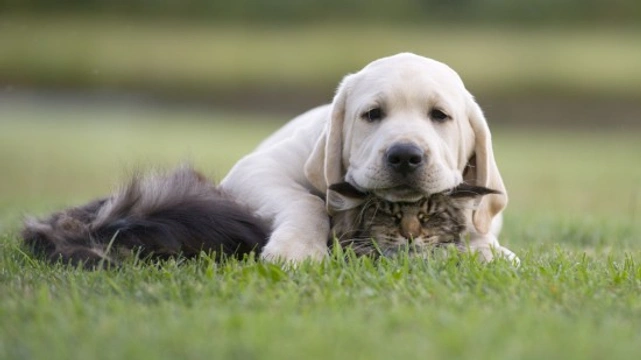
How to prevent your dog from chasing or attacking cats
Dogs of all breeds and types retain strong hunting and chasing instincts, as in the wild, their skills as hunters and scavengers were what kept them fed and healthy. Any smaller animal would theoretically be potential prey for the wild dog, and this includes cats! Obviously this is totally inappropriate within a domestic situation, and despite the fact that our pet dogs no longer have to hunt for food or worry about where their next meal is coming from, their prey drive remains strong nonetheless.
As the prey drive and the potential of seeing cats as another form of prey is very strong within the dog, it is not always possible to remove or negate their natural instincts. But you can successfully train and modify your dog’s behaviour to stop them pursuing cats, and even potentially teach them to live side by side with cats and see them as friends.
Read on to learn more about how to prevent your dog from chasing or hunting cats.
Breeds that are most likely to chase cats
It would be a mistake to assume that any breed or type of dog is unlikely to chase instinctively, as the hunting drive is something that all dogs possess very deeply within their instinctive behavioural make-up. However, some breeds and types of dogs are exponentially more likely to chase cats than others, and be harder to train out of doing so, as they were selectively bred and raised specifically for their superior hunting prowess.
Among these breeds and types of dogs are included all dogs from the terrier grouping, all sighthounds such as whippets, greyhounds and lurchers, herding dogs such as the Borer Collie, and sled dogs such as the Siberian Husky. Any other dog that has a breed ancestry involving scenting, hunting or working with prey animals will also likely have a high prey drive as well.
If your dog is likely to chase or hunt cats
Before you begin to train your dog around cats, it is important that cats are kept safe from your dog in every possible way. Never allow your dog out of your own properly enclosed garden or another enclosed space such as a dog park off the lead, and always walk your dog on the lead out in public, even if you do not expect any cats to be around.
Ways to reduce the prey drive in dogs
Spaying or neutering your dog is one of the most important steps in reducing their propensity to chase cats if they are apt to, as this also removes a large part of their potential aggression and desire to hunt.
Train your dog to respond to your commands reliably every time, and ensure that you have your core commands down to pat. Keep working on these throughout your dog’s life, to ensure that they retain their responsiveness and don’t forget their manners.
The most important commands to teach and instil in your dog when it comes to managing their hunting instincts are the recall command, and to leave something when they are told to. These can also be among the most challenging commands to teach and achieve perfect compliance with, and attaining this is covered in more depth in this article.
Ensure that your dog is adequately fed, particularly before they leave the house, in order to reduce any drive to pursue prey due to hunger. Make sure that your dog receives enough exercise too, so that they will remain responsive to you and not be apt to take off after something in order to stretch their legs.
Socialising your dog with cats
If cats are unfamiliar to your dog, they are exponentially more likely to see them as prey, whereas if you can teach your dog that cats are friends and pets, they will be less likely to chase them.
You will have the best chance of socialising your dog with cats successfully if you begin when the dog is as young as possible, and if your cat is already familiar with dogs and not likely to run from them instinctively. While most dogs can get to grips with the concept of having the family cat as part of their pack, strange cats that your dog comes across that run off when they see the dog might cause the trained-in control that your dog has achieved to be over-ridden by their instinctive prey drive.
Always make sure that the cat you are introducing your dog to has somewhere to retreat to and does not feel trapped, and if you have a bold and fearless cat that is not afraid of giving the dog a swipe on the nose if they get too pushy, this will teach your dog an important lesson about respecting cats!
Never leave your dog in the same room as your cat or able to get to your cat until you are totally confident that your dog will behave. Over time, your dog may bond strongly with your cat and enjoy cuddling up with them and playing with them, or at least build up a healthy respect for the species and know when to leave them alone!



